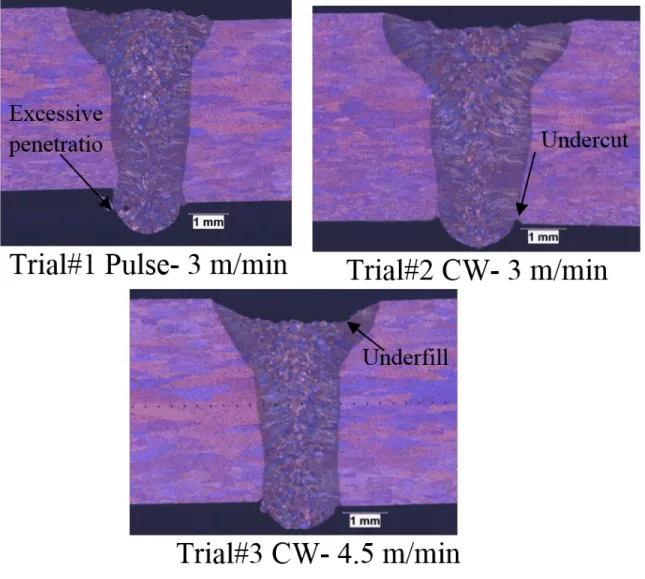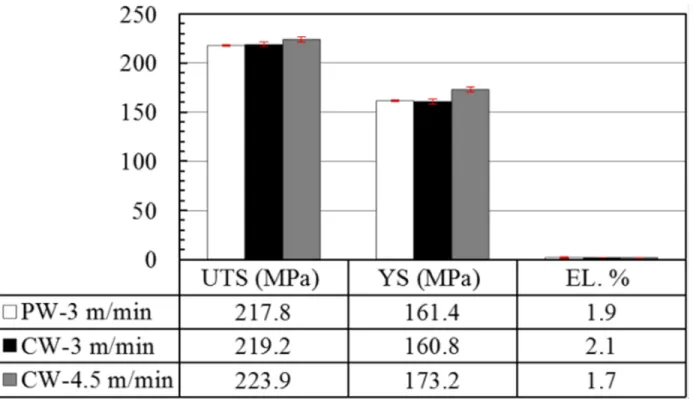Publisher’s version / Version de l'éditeur:
Vous avez des questions? Nous pouvons vous aider. Pour communiquer directement avec un auteur, consultez la première page de la revue dans laquelle son article a été publié afin de trouver ses coordonnées. Si vous n’arrivez pas à les repérer, communiquez avec nous à PublicationsArchive-ArchivesPublications@nrc-cnrc.gc.ca.
Questions? Contact the NRC Publications Archive team at
PublicationsArchive-ArchivesPublications@nrc-cnrc.gc.ca. If you wish to email the authors directly, please see the first page of the publication for their contact information.
https://publications-cnrc.canada.ca/fra/droits
L’accès à ce site Web et l’utilisation de son contenu sont assujettis aux conditions présentées dans le site LISEZ CES CONDITIONS ATTENTIVEMENT AVANT D’UTILISER CE SITE WEB.
LIA (Laser Institute of America) eNewsletter, 2017-10-23
READ THESE TERMS AND CONDITIONS CAREFULLY BEFORE USING THIS WEBSITE. https://nrc-publications.canada.ca/eng/copyright
NRC Publications Archive Record / Notice des Archives des publications du CNRC :
https://nrc-publications.canada.ca/eng/view/object/?id=d361fe4d-02bd-48a0-8012-8410098ad925 https://publications-cnrc.canada.ca/fra/voir/objet/?id=d361fe4d-02bd-48a0-8012-8410098ad925
NRC Publications Archive
Archives des publications du CNRC
This publication could be one of several versions: author’s original, accepted manuscript or the publisher’s version. / La version de cette publication peut être l’une des suivantes : la version prépublication de l’auteur, la version acceptée du manuscrit ou la version de l’éditeur.
For the publisher’s version, please access the DOI link below./ Pour consulter la version de l’éditeur, utilisez le lien DOI ci-dessous.
https://doi.org/10.2351/1.5040645
Access and use of this website and the material on it are subject to the Terms and Conditions set forth at
Single pass laser cold-wire welding of thick section AA6061-T6
aluminum alloy
SINGLE PASS LASER COLD-WIRE WELDING OF THICK SECTION AA6061-T6 ALUMINUM ALLOY
F. Mirakhorli1, F. Nadeau1, G. C.-Guillemette2
1National Research Council Canada, Saguenay, Québec, Canada G7H 8C3 2Bombardier Transport Canada Inc, La Pocatière, Québec, Canada, G0R 1Z0
Extending applications of thick aluminum alloys in various industrial market segments necessitates the development of advanced welding technologies to ensure high integrity welds. In the present work, single pass laser cold-wire welding of 4.8 mm thick AA6061-T6 aluminum plates was carried out in the butt joint configuration. The effect of laser welding parameters such as welding speed, continuous-wave (CW) and pulse-wave (PW) modes (Table 1) on weld integrity, microstructure and mechanical properties was evaluated. Porosity, underfill and excessive penetration were observed as the main imperfections in the fusion zone as displayed in X-Ray photographs (Figure 1) and metallographic pictures (Figure 2). However, the underfill depth and excessive penetration height in the joints manufactured at different welding conditions met the specifications of ISO 13919 standard. Porosity qualifications i.e., Max. porosity and cluster dimensions, and porosity area fraction, in PW mode passed the minimum
requirement criteria of the stringent ISO 13919-2 standard quality class (level B), while these porosity qualifications in CW, at 3 m/min welding speed just passed the quality level C criteria as displayed in Table 2. By increasing the welding speed from 3 m/min to 4.5 m/min in CW mode, the maximum single and cluster porosity dimensions, and porosity area fraction are reduced significantly. These results indicate that both laser mode and travel speed can influence the porosity formation during laser cold-wire welding of AA6061-T6 aluminum plate. Welding in PW mode versus CW mode, at the same travel speed and at a similar average power can reduce the porosity area fraction by ~64%.. Increasing the welding speed from 3 to 4.5 m/min in CW laser mode reduce the porosity area fraction by ~75%. This can be due to an increase in keyhole stability at higher welding speed.
Figure 3 displays the SEM- microstructure in fusion zone (FZ) center and near fusion line at different welding parameters. Microvoids were observed in FZ, forming mostly at interdendiritc grain boundaries and heat affected zone (HAZ) close to fusion line (FL). These microvoids form between low-melted eutectic phase and matrix at the last stage of solidification due to the high thermal shrinkage strains generated during weld solidification [1, 2]. The microvoids can coalescence and form a microcrack which reduce static or dynamic mechanical properties.
The microhardness evolution across the FZ, HAZs and base metal (BM) was measured along the mid-thickness of the welds cross-section (Figures 4). The average measured hardness of the AA6061-T6 BM was 109 HV. The minimum microhardness was related to FZ with the average hardness values given in Figure 4. The FZ average hardness is slightly higher in PW mode compared to CW mode welded assemblies. The higher microhardness in FZ in PW mode can be due to the less interaction time and consequently less specific point energy transferred to metal surface, which lead to a lower heat input and less evaporation of volatile element such as Mg.
The highest hardness in HAZ was attributed to the CW mode welded assembly at 4.5 m/min with average hardness of 87 HV which was close the HAZ microhardness in pulse mode with average value of 80 HV. The higher HAZ hardness in trial 3 can be due to the higher welding speed of 4.5 m/min. The lowest HAZ hardness value (71 HV) corresponded to the condition welded at 3 m/min and CW mode. A significant drop in hardness values of FZ and HAZ compared to BM after laser welding in all samples were observed. This decrease in FZ microhardness is due to the lack of hardening precipitates in FZ which is comparable to an as-cast microstructure during laser welding heat cycle.
Transverse tensile properties such as ultimate tensile strength (UTS), yield strength (YS) and percentage of elongation at rupture (El. %) were evaluated for different welding trials as shown in Figure 5. The average UTS, YS, and El.% values for all the welds were quite similar (with 1%-2.5% variation between Min. and Max. values). The tensile properties of laser welded 2 mm thick 6061-T6 was reported as 181 MPa and 146 MPa, for UTS and YS respectively [3]. Friction stir welding of 3.0 mm thick AA6061-T6 plates show a UTS up to 240 MPa [4] is slightly higher than the results obtained in this study for laser cold-wire welding process. The results of elongation at fracture values in PW and CW mode, ranges from 1.7% to 2.1% using a 50 mm mechanical extensometer gage length as shown in Figure 4. This states that the total absolute elongation ranges from 0.85 to 1.05mm. Assuming that the major part of the
deformation is taking place at the lowest micro-hardness location, thus HAZ, we can calculate the joint ductility at this specific location. As the HAZ width is ~4 mm, then the elongation in HAZ ranges from 20.7 and 25.6% which is in line with other laser welding local elongation values up to fracture, reported earlier in aluminium alloys [5].
Conclusion
4.8 mm- thick AA6061-T6 aluminium alloy was welded successfully, using the laser cold-wire welding process. Porosity, underfill and excessive penetration were the most common welding defects which passed the requirement criteria according to ISO 13919-2 standard (level B and C). The average ultimate tensile and yield strengths values for the welds were 220 MPa and 165 MPa respectively.
Reference
[1] X. Cao, W. Wallace, J.-P. Immarigeon, and C. Poon (2003) Research and progress in laser welding of wrought aluminum alloys. II. Metallurgical microstructures, defects, and mechanical properties, Materials and Manufacturing Processes, vol. 18, pp. 23-49.
[2] N. Coniglio. (2008).Aluminum alloy weldability: Identification of weld solidification cracking mechanisms through novel experimental technique and model development: BAM.
[3] D. Narsimhachary (2014) Effect of laser welding parameters on 6061 aluminium alloy.
[4] P. Moreira, A. De Jesus, A. Ribeiro, and P. De Castro (2008) Fatigue crack growth in friction stir welds of 6082-T6 and 6061-T6 aluminium alloys: a comparison, Theoretical and Applied Fracture Mechanics, vol. 50, pp. 81-91.
[5] J. Liu, L.-L. Wang, J. Lee, R. Chen, O. El-Fakir, L. Chen, et al. (2015) Size-dependent mechanical properties in AA6082 tailor welded specimens, Journal of Materials Processing Technology, vol. 224, pp. 169-180.
Table 1. Laser cold-wire parameters
Table 2 Porosity quantification in welds based on X-Ray photographs
Max. single porosity dimension
Max. cluster porosity dimension
Porosity area fraction
Trial #1 1 mm 1.2 mm 2.0% Trial #2 1.7 mm 2.2 mm 5.6% Trial #3 1.2 mm NA 1.4% Level B (1.44 mm)h ≤ 0.3t (1.44 mm)h ≤ 0.3t f ≤ 3% Level C (1.92 mm)h ≤ 0.4t (1.92 mm)h ≤ 0.4t f ≤ 6% Parameters Trial # 1 Trial # 2 Trial # 3
Laser peak power (kW) 10 6.5 8
Laser average power
(kW) 6.7 -
-Laser mode PW CW CW
Defocused distance (mm) -4 -4 -4
Travel speed (m/min) 3 3 4.5
Pulse duration (ms) 20 -
-Interaction time (ms) 14 20 13
Specific point energy (J) 94 130 104
WFS (m/min) 5 5 6.7
Filler wire consumption (g/m)




